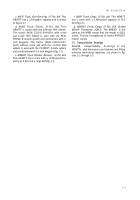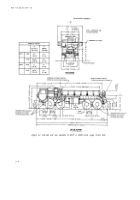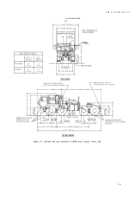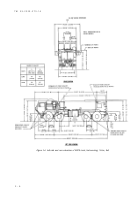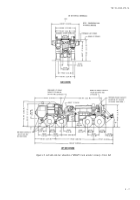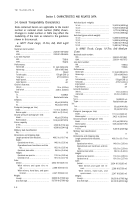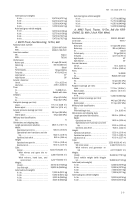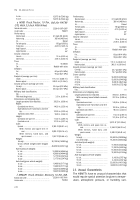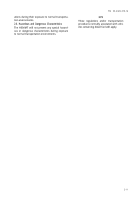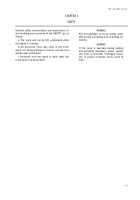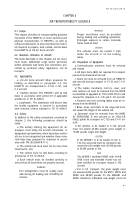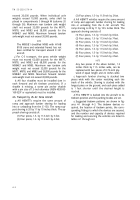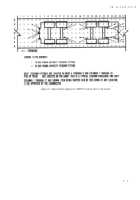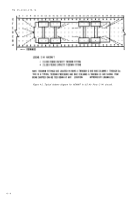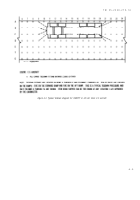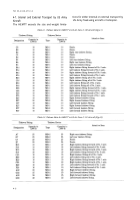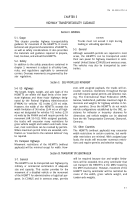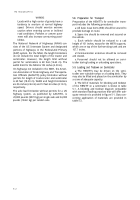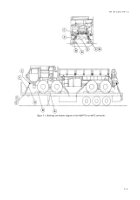TM-55-2320-279-14 - Page 17 of 46
TM 55-2320-279-1 4
CHAPTER 4
AIR TRANSPORTABILITY GUIDANCE
4-1. Scope
This chapter provides air transportability guidance
movement of the HEMTTs. It covers technical and
physical characteristics of HEMTTs, as well as
safety considerations. It also prescribes the materi-
als required to prepare, load, unload, and tie down
the HEMTTs on US Air Force aircraft.
4-2. Maximum Utilization of Aircraft
The loads described in this chapter are not maxi-
mum loads. Additional cargo and/or personnel
within allowable load limits and restrictions, pre-
scribed by pertinent safety regulations, can be
transport.
4-3. Applicability
a. US Air Force Aircraft.
When prepared for
loading as described in paragraph 4-5, the
HEMTTs are transportable in C-130, C-141, and
C-5 aircraft.
b. Tiedown Devices.
The HEMTTs will be tied
down in accordance with section IV of applicable
procedures in TO IC-XXX-9.
c.
Loadmaster.
The loadmaster will ensure that
the loaded equipment is secured in accordance
with restraint criteria outlined in TO 1C–XXX-9.
4-4. Safety
In addition to the safety precautions contained in
chapter 3, the following procedures should be
noted:
a.
The activity offering the equipment for air
transport must notify the aircraft commander, or
designated representative, when hazardous materi-
als are to be transported and whether these mate-
rials have been prepared for shipment in accord-
ance with TM 38-250/AFR 71-4.
b.
The vehicle fuel tank must not be more than
three-fourths full.
c. The vehicle must be tied down according to
procedures in TO 1C-XXX-9.
d.
Each vehicle must be checked carefully to
ensure that all loose items are properly secured.
WARNING
Fire extinguishers must be
able during all loading and
erations.
readily avail-
unloading op-
WARNING
Proper ventilation must be provided
during loading and unloading operations.
Prolonged exposure to carbon monoxide
fumes could be fatal.
CAUTION
The vehicles must not exceed 3 mph
inside the aircraft or on the loading
ramps.
4-5. Preparation of Equipment
a.
Communication antennas must be removed
and stowed.
b.
All basic items (BII) not required for transport
use must be stowed and secured.
c. Spare tire must be removed from all HEMTTs
and secured during transport in C-130 and C–141
aircraft.
d.
The ladder, handrails, mirrors, cover, and
vent rollover rail must be removed from the M978
as identified in appendix E, TM 9-2320-279-10 and
secured for shipment in C–130 and C-141 aircraft.
e.
Forward and rear warning lights must be re-
moved from the M984E1.
f.
Bows, tarps, and items in the cargo bed must
not exceed the height of the vehicle cab.
g. Generator must be removed from the M983
for PERSHING II and secured to an HCU-6/E
(463L) pallet for transport in C-130 and C-141 air-
craft.
h.
All vehicles to be loaded in C-130 aircraft
must not exceed 43,000 pounds gross weight or
13,000 pounds single axle weight.
CAUTION
If the M984E1 is to be loaded on the C-
130, the cargo bed must be removed to de-
crease the curb weight from 50,900 pounds
to 43,000 pounds or less.
NOTE
The M985E1 (modified M985 with H1AB
8108 crane and extended frame) has not
been certified for transport aboard C-130
aircraft.
i.
For C–141 transport, the gross weight must
not exceed 62,000 pounds for the M977, M978, and
M983 and 68,000 pounds for the M984E1 and
M985. Maximum individual axle weight must not
4-1
Back to Top

